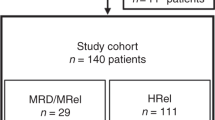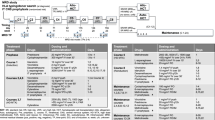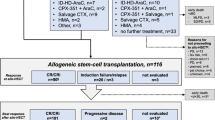Abstract
We previously reported preliminary findings that post induction imatinib mesylate (340 mg/m2/day), in combination with intensive chemotherapy, resulted in outcomes similar to blood and marrow transplant (BMT) for pediatric patients with Philadelphia chromosome-positive (Ph+) acute lymphoblastic leukemia (ALL). We now report 5-year outcomes of imatinib plus intensive chemotherapy in 91 children (1–21 years) with and without allogeneic BMT (N=91). We explore the impacts of additional chromosomal abnormalities and minimal residual disease (MRD) by flow cytometry on outcomes. The 5-year disease-free survival was similar for Cohort 5 patients, treated with chemotherapy plus imatinib (70%±12%, n=28), sibling donor BMT patients (65%±11%, n=21) and unrelated donor BMT patients (59±15%; P=0.60, n=13). Patients with additional cytogenetic abnormalities had worse outcomes (P=0.05). End induction (pre-imatinib) MRD was not prognostic for Cohort 5 or allogeneic BMT patients, although limited by small numbers. The re-induction rate following relapse was similar to other higher-risk ALL groups. Longer-term follow-up confirms our initial observation of substantially good outcomes for children and adolescents with Ph+ ALL treated with imatinib plus intensive chemotherapy with no advantage for allogeneic BMT.
This is a preview of subscription content, access via your institution
Access options
Subscribe to this journal
Receive 12 print issues and online access
$259.00 per year
only $21.58 per issue
Buy this article
- Purchase on Springer Link
- Instant access to full article PDF
Prices may be subject to local taxes which are calculated during checkout



Similar content being viewed by others
References
Aricò M, Schrappe M, Hunger SP, Carroll WL, Conter V, Galimberti S et al. Clinical outcome of children with newly diagnosed Philadelphia chromosome-positive acute lymphoblastic leukemia treated between 1995 and 2005. J Clin Oncol 2010; 28: 4755–4761.
Gaynon PS, Trigg ME, Heerema NA, Sensel MG, Sather HN, Hammond GD et al. Children's Cancer Group trials in childhood acute lymphoblastic leukemia: 1983-1995. Leukemia 2000; 14: 2223–2233.
Maloney KW, Shuster JJ, Murphy S, Pullen J, Camitta BA . Long-term results of treatment studies for childhood acute lymphoblastic leukemia: Pediatric Oncology Group studies from 1986–1994. Leukemia 2000; 12: 2276–2285.
Pui CH, Evans WE . Treatment of acute lymphoblastic leukemia. N Engl J Med 2006; 354: 166–178.
Aricò M, Valsecchi MG, Camitta B, Schrappe M, Chessells J, Baruchel A et al. Outcome of treatment in children with Philadelphia chromosome-positive acute lymphoblastic leukemia. N Engl J Med 2000; 342: 998–1006.
Steinherz PG, Redner A, Steinherz L, Meyers P, Tan C, Heller G . Development of a new intensive therapy for acute lymphoblastic leukemia in children at increased risk of early relapse. The Memorial Sloan-Kettering-New York-II protocol. Cancer 1993; 72: 3120–3130.
Bowman WP, Larsen EL, Devidas M, Linda SB, Blach L, Carroll AJ et al. Augmented therapy improves outcome for pediatric high risk acute lymphocytic leukemia: results of Children's Oncology Group trial P9906. Pediatr Blood Cancer 2011; 57: 569–577.
Schultz KR, Aledo A, Bowman WP, Slayton WB, Sather H, Devidas M et al. Improved early event free survival (EFS) with tolerable toxicity in children with philadelphia chromosome positive (Ph+) acute lymphoblastic leukemia (ALL) with intensive imatinib mesylate with dose-intensive multiagent chemotherapy: Children's Oncology Group (COG) Study AALL0031. J Clin Oncol 2009; 27: 5175–5181.
Yanada M, Takeuchi J, Sugiura I, Akiyama H, Usui N, Yagasaki F et al. Karyotype at diagnosis is the major prognostic factor predicting relapse-free survival for patients with Philadelphia chromosome-positive acute lymphoblastic leukemia treated with imatinib-combined chemotherapy. Haematologica 2008; 93: 287–290.
Towatari M, Yanada M, Usui N, Takeuchi J, Sugiura I, Takeuchi M et al. Combination of intensive chemotherapy and imatinib can rapidly induce high-quality complete remission for a majority of patients with newly diagnosed BCR-ABL-positive acute lymphoblastic leukemia. Blood 2004; 104: 3507–3512.
Borowitz MJ, Pullen DJ, Shuster JJ, Viswanatha D, Montgomery K, Willman CL et al. Children's Oncology Group study. Minimal residual disease detection in childhood precursor-B-cell acute lymphoblastic leukemia: relation to other risk factors. A Children's Oncology Group study. Leukemia 2003; 17: 1566–1572.
Borowitz MJ, Devidas M, Hunger SP, Bowman WP, Carroll AJ, Carroll WL et al. Clinical significance of minimal residual disease in childhood acute lymphoblastic leukemia and its relationship to other prognostic factors: A Children's Oncology Group study. Blood 2008; 111: 5477–5485.
Kaplan EL, Meier P . Nonparametric estimation from incomplete observations. J Am Stat Assoc 1958; 53: 457–481.
Peto R, Peto J . Asymptotically efficient rank invariant test procedure. J Royal Stat Soc 1972; 135: 185–198.
Bader P, Kreyenberg H, Henze GH, Eckert C, Reising M, Willasch A et al. ALL-REZ BFM Study Group. Prognostic value of minimal residual disease quantification before allogeneic stem-cell transplantation in relapsed childhood acute lymphoblastic leukemia: the ALL-REZ BFM Study Group. J Clin Oncol 2009; 27: 377–384.
Raetz EA, Borowitz MJ, Devidas M, Linda SB, Hunger SP, Winick NJ et al. Reinduction platform for children with first marrow relapse of acute lymphoblastic Leukemia: A Children's Oncology Group Study[corrected]. J Clin Oncol 2008; 26: 3971–3978.
Biondi A, Schrappe M, De Lorenzo P, Castor A, Lucchini G, Gandemer V et al. Imatinib after induction for treatment of children and adolescents with Philadelphia-chromosome-positive acute lymphoblastic leukaemia (EsPhALL): a randomised, open-label, intergroup study. Lancet Oncol 2012; 13: 936–945.
Acknowledgements
We sincerely thank Laura Francisco for invaluable data management support, Tammie Eslinger, CCRP, for outstanding protocol development and performance support and Bernice Pasut, RN, for diligent and thorough protocol development support. SPH is the Ergen Family Chair in Pediatric Cancer. This work was supported by grants CA98543 and CA29139.
Author contributions
Kirk R Schultz designed the research, performed the research, analyzed the data and wrote the paper. Andrew Carroll performed the research, analyzed the data and wrote the paper. Nyla A Heerema performed the research, analyzed the data and wrote the paper. W Paul Bowman designed the research, performed the research, analyzed the data and wrote the paper. Alexander Aledo designed the research, performed the research and wrote the paper. William B Slayton designed the research, performed the research and wrote the paper. Harland Sather designed the research, analyzed the data and wrote the paper. Meenakshi Devidas designed the research, analyzed the data and wrote the paper. Hao W Zheng analyzed the data. Stella M Davies designed the research and wrote the paper. Paul S Gaynon designed the research and wrote the paper. Michael Trigg designed the research and wrote the paper. Robert Rutledge designed the research and wrote the paper. Dean Jorstad designed the research and wrote the paper. Naomi Winick performed the research and wrote the paper. Michael J Borowitz performed the research, analyzed the data and wrote the paper. Stephen P Hunger designed the research, performed the research and wrote the paper. William L Carroll designed the research, performed the research and wrote the paper. Bruce Camitta designed the research, performed the research and wrote the paper.
Author information
Authors and Affiliations
Consortia
Corresponding author
Ethics declarations
Competing interests
The authors declare no conflict of interest.
Rights and permissions
About this article
Cite this article
Schultz, K., Carroll, A., Heerema, N. et al. Long-term follow-up of imatinib in pediatric Philadelphia chromosome-positive acute lymphoblastic leukemia: Children's Oncology Group Study AALL0031. Leukemia 28, 1467–1471 (2014). https://doi.org/10.1038/leu.2014.30
Received:
Accepted:
Published:
Issue Date:
DOI: https://doi.org/10.1038/leu.2014.30
Keywords
This article is cited by
-
Maintenance Treatment in Acute Lymphoblastic Leukemia: A Clinical Primer
Indian Journal of Pediatrics (2024)
-
Philadelphia Chromosome Positive and Philadelphia-Like Acute Lymphoblastic Leukemia in Children and Adolescents: Current Management, Controversies and Emerging Concepts
Indian Journal of Pediatrics (2024)
-
Allogeneic hematopoietic stem cell transplantation for pediatric acute lymphoblastic leukemia
Annals of Hematology (2024)
-
Whole genome sequencing provides comprehensive genetic testing in childhood B-cell acute lymphoblastic leukaemia
Leukemia (2023)
-
The Outcome of Pediatric Philadelphia Chromosome-Positive Acute Lymphoblastic Leukemia: Experience from a Referral Center in South India
Indian Journal of Hematology and Blood Transfusion (2023)



